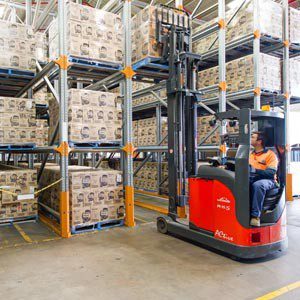What Are The Benefits Of Drive In Pallet Racking?
When it comes to warehouse storage, not all pallet racking is the same. When you’re trying to determine the best storage solution for your business, it’s important to note that there are different types of pallet racking and each types has its advantages, disadvantages, and use cases.
One of these types of pallet racking is drive-in pallet racking. Like all types of pallet racking, drive-in pallet racking can be extremely useful in specific situations, but it’s not a type of pallet racking to use in every situation.
Let’s explore drive-in pallet racking, when to use it, and even some situations where it may not be the best choice of racking for warehouse storage.
What Is Drive-In Pallet Racking?
Drive-In Pallet Racking stores pallets multi-deep and is designed for the pallets to be accessed via a forklift driving into the racking. Since pallets are stored multi-deep and there’s no need for aisles between racking, drive in pallet racking is a very dense storage solution for warehouses.
Drive-In Pallet racking can also be adapted for a variety of pallet sizes and forklift types.
The Benefits Of Drive-In Pallet Racking
Drive-In pallet racking is great in specific circumstances. When used correctly, it’s a cost effective storage solution for pallets.
Drive-in pallet racking allows for dense storage. We’ve already mentioned this, but it’s the biggest benefit of drive-in pallet racking. By eliminating the need for aisles between racks, more warehouse space can be devoted to storage. Furthermore, there’s virtually no limit to how deep pallets can be stored with drive-in pallet racking.
Drive-in pallet racking can be cost effective. This especially the case when weighing up the cost of pallet racking versus the cost of real estate. While drive-in pallet racking is often more expensive than simple selective pallet racking, the increased storage density means that less warehouse space is needed, which can be good in areas with high real estate costs.
Drive-in pallet racking works well with multiple pallets of the same SKU. Since pallets are stored multi-deep, drive-in pallet racking is most effective if you’re storing multiple pallets of the same SKU. This utilises as much storage space as possible by filling the entire row with the same SKU.
Drive-in pallet racking allows for fast pallet retrieval. When used properly, pallet retrieval can be very quick in drive-in pallet racking, it’s just a matter of driving a forklift to the correct position and retrieving the pallet.
Disadvantages Of Drive-In Pallet Racking
While drive-in pallet racking works well in certain situations, it’s not a catch all high density pallet storage solution. Used incorrectly, drive-in pallet racking can be a hassle and be relatively ineffective.
Drive-in pallet racking is first in, last out storage. This may not be a disadvantage for some goods, but for others first in, last out storage is not appropriate. If your storage needs dictate that a first in, first out system is needed, it’s unlikely that drive-in pallet racking is right for your warehouse, but there may be ways to balance the density with ease of access.
Selectivity of pallets is decreased with drive-in pallet racking. Since some pallets are stored behind others, naturally there is a reduction in selectivity when drive-in pallet racking is used. Drive-in pallet racking is meant to be used with multiple pallets of the same SKU though, so any pallet that’s blocked in would only be blocked in by a pallet of the same SKU.
Storage space may be lost if there aren’t enough pallets of the same SKU. While it’s almost impossible for any warehouse to have 100% utilisation of its storage space, with drive-in pallet racking, it’s possible to have very low utilisation of rows if there aren’t enough pallets of the same SKU to fill them. This is why it’s important to understand the benefits of drive-in pallet racking and its specific use cases.
Drive-In Pallet Racking Use Cases
Drive-in pallet racking works best in situations where there are multiple pallets of the same SKU. This allows for all the same SKU pallets to be stored in the same row for easy retrieval. Since drive-in pallet racking is first in, last out, it’s also important to only use it in situations where first in, last out is suitable. That being said, drive-in pallet racking works well in high throughput situations where stock is rotated enough that the difference between first in, first out and first in, last out is effectively negated.
With this in mind, it may be surprising to hear that drive-in pallet racking can be effective in cold storage. This is because cold storage can be expensive, so it’s important to store pallets as dense as possible. With enough stock rotation, drive-in pallet racking can be very efficient here.
Find Out The Pallet Racking That’s Right For Your Needs
There’s more to pallet racking that just selective pallet racking and drive-in pallet racking. Some situations call for one type of pallet racking, others call for a variety of different types of pallet racking. There are a lot of pallet racking options out there, so feel free to contact us to discuss your needs. We’re happy to help.


Comments are closed.